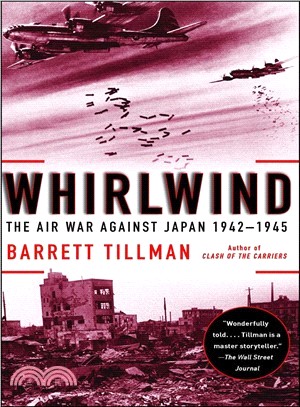Whether describing the experiences of bomber crews based in China or the Marianas, fighter pilotson Iwo Jima, or carrier aviators at sea, Tillman provides vivid details of the lives of the fliers and their support personnel. Whirlwind takes readers into the cockpits and gun turrets of the mighty B-29 Superfortress, the largest bomber built up to that time. Tillman dramatically re-creates the sweep of wartime emotions that crews endured on fifteen-hour missions, grappling with the extreme tedium of cramped spaces and with adrenaline spikes in flak-studded skies, knowing that a bailout would put them at the mercy of a merciless enemy or an unforgiving sea.
A major character is the controversial and brilliant General Curtis LeMay, who rewrote strategic bombing tactics. His command’s fire-bombing missions incinerated fully half of Tokyo and many other cities, crippling Japan’s industry while still failing to force surrender.
Whirlwind examines the immense logistics and construction efforts necessary to support Superfortresses in Asia and the Mariana Islands, as well as the tireless efforts of engineers to build huge air bases from scratch.It also describes the unheralded missions that American bomber crews flew from the Aleutian Islands to Japan’s northernmost Kuril Islands.
Never has the Japanese side of the story been so thoroughly examined. If Washington, D.C., represented a “second front” in Army-Navy rivalry, the situation in Tokyo approached a full-contact sport. Tillman’s description of Japan’s willfully inadequate approach to civil defense is eye-opening. Similarly, he examines the mind-set in Tokyo’s war cabinet, which ignored the atomic destruction of Hiroshima and Nagasaki, requiring the emperor’s personal intervention to avert a ghastly Allied invasion.
Tillman shows how, despite the Allies’ ultimate success, mistakes and shortsighted policies made victory more costly in lives and effort. He faults the lack of a unified command for allowing the Army Air Forces and the Navy to pursue parochial goals at the expense of the larger mission, and he questions the premature commitment of the enormously sophisticated B-29 to the most primitive theater in India and China.
Whirlwind is one of the last histories of World War II written with the contribution of men who fought in it.With unexcelled macro- and microperspectives, Whirlwind is destined to become a standard reference on the war, on multiservice operations, and on the human capacity for individual heroism and national folly.











